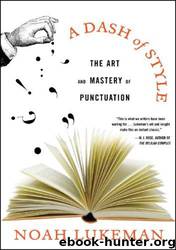A Dash of Style: The Art and Mastery of Punctuation by Noah Lukeman

Author:Noah Lukeman [Lukeman, Noah]
Language: eng
Format: epub
Tags: Language Arts & Disciplines, Linguistics, Grammar, Reference, Writing Skills, English Language, General, Grammar & Punctuation, Composition & Creative Writing, English language - Punctuation
ISBN: 9780393329803
Publisher: W. W. Norton & Company
Published: 2007-03-27T04:30:11+00:00
and this eventually evolved into the modern-day paragraph break, which is, of course, indicated today by only a line break and indentation. The indentation we use today was originally there for early printers, so that they would have space for the large illuminated letter that used to herald paragraphs. The illuminated letter no longer exists, but, luckily for tired readers, the spacing does.
Today the paragraph break is indicated only by absence, which is perhaps why it is glossed over in discussions about punctuation. This is a shame, because it is one of the most crucial marks in the punctuation world. It is used thousands of times in any given book, and it alone can make or break a work. Few places are more visible than
the beginnings and endings of paragraphs: with their ample spacing, they are eye catching. As such the paragraph break has an unparalleled ability to propel into the limelight, offering perpetual opportunities to grab readers with new hooks. It has the unique power to frame a cluster of sentences, to give them shape and meaning, to resolve the theme of the current paragraph and set the stage for the paragraph to come. Indeed, this is why some speed-reading courses teach readers to read merely the beginnings and endings of paragraphs.
The paragraph break is a big brother to the period: the period divides sentences, while the paragraph break divides groups of sentences. Just as a sentence must have a beginning and appropriate ending, so must a paragraph. Yet while the period is paid homage to as the backbone of punctuation, the paragraph break is largely ignored. This is ironic, since its role could be considered even more pivotal than the period, as it effects not just one sentence, but many. If the period is a stop sign, then the paragraph break is a stoplight at a major intersection.
The section break (also known as the line space) is the most subjective of punctuation marks. It is rarely discussed, and there is not even a consensus on how to indicate it. In manuscript form, this mark is generally indicated by a blank line followed by text set flush left, or by a single asterisk, or by a set of asterisks running across the page, centered and evenly spaced with a tab between each. In a bound book, it is usually indicated by a line space between two paragraphs, but you'll also find it indicated by a wide variety of symbols, from a star, to some small graphic in line with the theme of the book, such as a miniature ship in a book about the sea. Regardless of the visual, they all serve the same purpose: to indicate a section break.
The section break is used to delineate sections within chapters, which might range from several paragraphs to several pages. It signifies a major transition within a chapter, usually a change of time, place, or even viewpoint. It indicates to the reader that, although the chapter isn't finished, he can comfortably pause and digest what he's read.
Download
This site does not store any files on its server. We only index and link to content provided by other sites. Please contact the content providers to delete copyright contents if any and email us, we'll remove relevant links or contents immediately.
Asking the Right Questions: A Guide to Critical Thinking by M. Neil Browne & Stuart M. Keeley(5633)
Autoboyography by Christina Lauren(5183)
Eat That Frog! by Brian Tracy(4434)
Dialogue by Robert McKee(4321)
Sticky Fingers by Joe Hagan(4101)
Journeys Out of the Body by Robert Monroe(3571)
Annapurna by Maurice Herzog(3423)
Full Circle by Michael Palin(3387)
Schaum's Quick Guide to Writing Great Short Stories by Margaret Lucke(3319)
Elements of Style 2017 by Richard De A'Morelli(3307)
The Art of Dramatic Writing: Its Basis in the Creative Interpretation of Human Motives by Egri Lajos(3015)
Atlas Obscura by Joshua Foer(2898)
The Diviners by Libba Bray(2886)
In Patagonia by Bruce Chatwin(2875)
Why I Write by George Orwell(2874)
The Fight by Norman Mailer(2848)
The Mental Game of Writing: How to Overcome Obstacles, Stay Creative and Productive, and Free Your Mind for Success by James Scott Bell(2845)
Venice by Jan Morris(2524)
The Elements of Style by William Strunk and E. B. White(2440)
